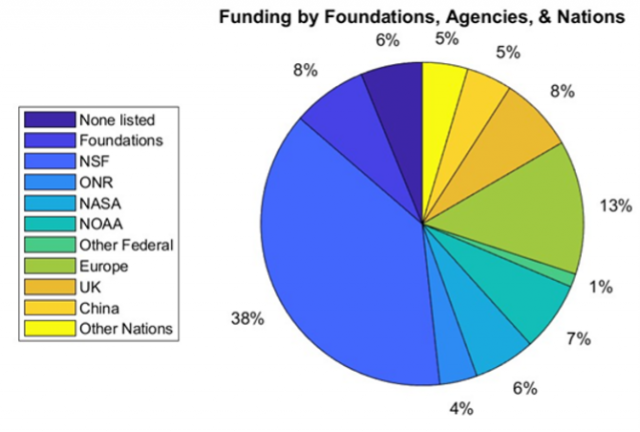Posts Tagged ‘Data News’
OOI Data: An Ever Growing Userbase
The collection, archive, and delivery of high-quality oceanographic data to the scientific community is central to the mission of the Ocean Observatories Initiative’s (OOI). Researchers world-wide are taking advantage of the 134 billion rows of freely available OOI data to make discoveries about the oceans and atmosphere. Funded by the National Science Foundation (NSF), the OOI was designed to collect and serve ocean data for up to 30 years. The 30-year timescale makes it possible to measure and observe both short-lived episodic events and longer-term changes occurring in the ocean. Such data are critical to increasing knowledge about ocean processes and if and how the ocean is changing.
How OOI Data Are Being Used
Since OOI data are freely available to anyone with an internet connection, researchers in organizations ranging from small land-locked colleges to major international oceanographic institutions are using OOI data in their scientific investigations. The next generation of ocean scientists are increasingly using OOI data as evidenced by the topics of PhD dissertations and honor theses. The Ocean Data Labs Project also has inspired thousands of students and their college professors to integrate real-time ocean data in the classroom. The project published an OOI Lab Manual, designed for use in introductory oceanography courses providing students and teachers the opportunity to apply timely and even real-time oceanographic data into their studies.
OOI has a broad and increasing science user base, as reflected in the number of OOI-related publications that advancing scientific understanding of ocean processes. The OOI-related publications and the Web of Science citation statistics are compiled by the WHOI-Marine Biological (MBL) Library through Web of Science and Dimensions searches on the main literature databases. The search terms include keywords such as “Ocean Observatories Initiative”, “Irminger Sea Array”, “Global Station Papa”, “Pioneer Array”, “Coastal Pioneer”, “OOI Pioneer”, “Endurance Array“, “Regional Cabled Array”, etc. The subset of publications using OOI data is identified by the OOI PI team. A complete, searchable list of OOI-related publications can be found here.
Table 2: Publications and NSF awards from 1 January 2013 through 31 March 2023
|
Metric |
OOI-related publications in refereed journals | Subset of publications using OOI data or infrastructure |
NSF Awards |
| Number of publications or awards | 326 | 177 | 129 total $66.4M |
| Total Web of Science citations | 4295 | 2250 | Not applicable |
| Sum of Altmetrics scores | 4679 | 2795 | Not applicable |
| Distinct lead authors or PIs | 263 | 146 | 96 |
| Distinct lead institutions | 143 | 73 | 49 |
| Countries | 24 | 16 | USA only |
This process does not necessarily capture all publications that use OOI data, particularly publications that use data obtained from third-party sites that ingest and serve OOI data (e.g., IRIS, Glider DAC and GOA-ON) that would not fall under our keywords. OOI is actively working to improve our ability to identify OOI-related publications by minting DOIs for our data sets.
Even so, this past year’s total for OOI-related publications is the largest to date. The resulting statistics show that OOI data and its infrastructure has been used in 177 peer-reviewed publications since 2013 and has been described, mentioned and/or motivated research in 147 others as shown in Table 1. The number of publications has grown steadily since 2013 as shown in Figure 1. The total given for 2023, represents the first quarter of that calendar year, and we are on tract to meet or beat last year’s total.
[caption id="attachment_26011" align="aligncenter" width="900"]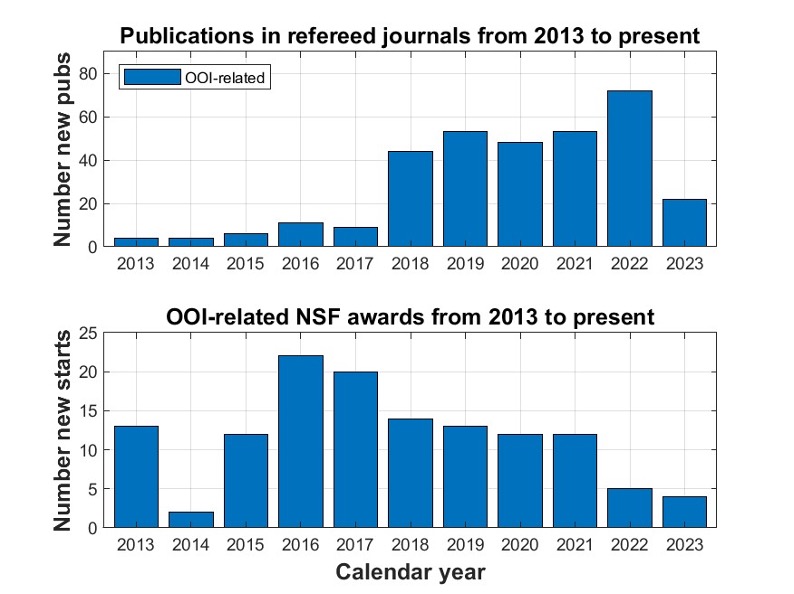
Figure 1. (top panel) the number of publications in refereed journals by year. (bottom panel) The number of OOI-related NSF grants by year. They do not include those grants that support OOI operations and maintenance (O&M).[/caption]
The OOI funding information is obtained from the NSF website by searching awards for “Ocean Observatories Initiative” in their abstracts, selecting those with greater than a particular percentage of relevance and rejecting outliers (such as the OOI O&M and OOIFB awards). Our searches use a cutoff for percentage of relevance of 68%, which provides a meaningful comparison of OOI-related NSF awards from 2013 to the present. The OOI was commissioned in 2016, coincident with the significant jump in NSF-funded OOI-related awards shown in Figure 1. Since that time, the number of awards has slowly dropped, possibly due to impacts from COVID-19. Interestingly, the decrease in NSF awards coincided with rapid growth in publications. We can think of several reasons for this including:
- The freely available OOI data that can be used directly for research without a dedicated NSF (or other) award.
- The use of other funding sources to analyze and publish OOI data.
- The need to expand our search to include other keywords in addition to “Ocean Observatories Initiative.”
We believe that all three play a role in the number of new starts supported by the NSF. This is particularly true of reason (2) for which there is clear evidence in the A Growing Global Reach section provided below.
Improved Accessibility
The OOI has developed an easy-to-use tool to explore and visualize OOI data known as Data Explorer, which was launched in October 2020. The number of users using this tool has been on a steady trajectory of growth since its inception. For example, Figure 2 shows the number of
[caption id="attachment_26014" align="aligncenter" width="900"]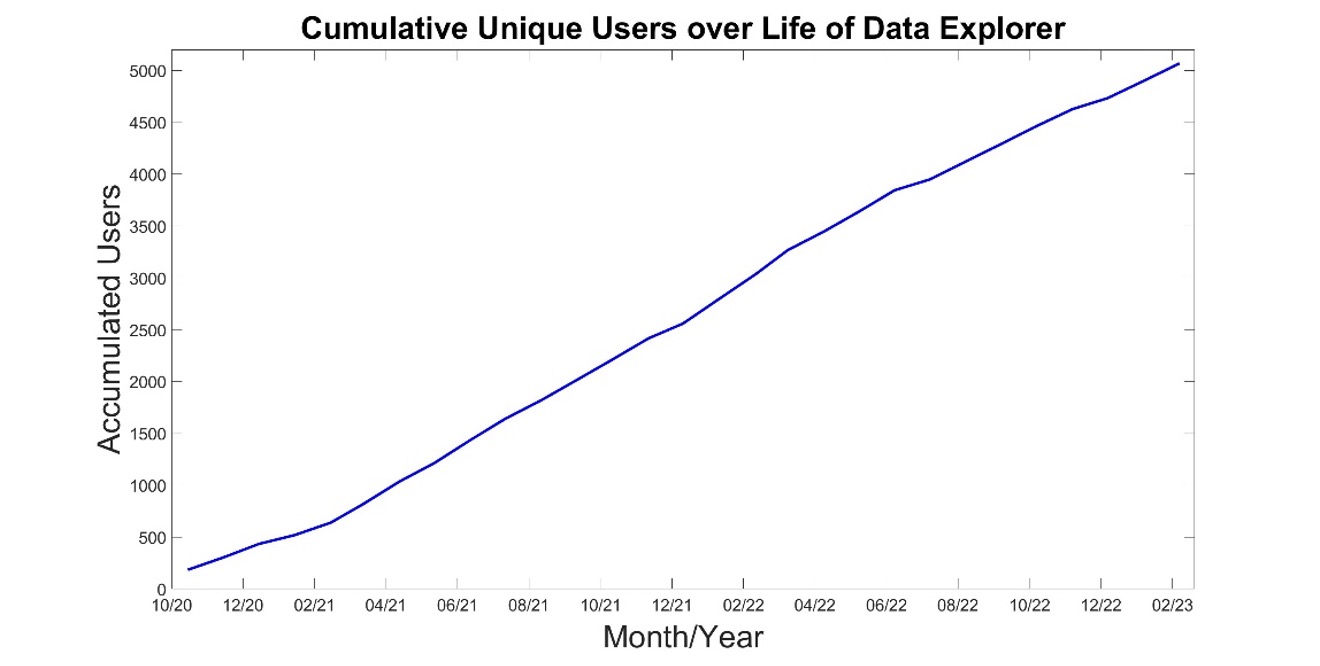 Figure 2. A time series of the accumulated number of unique users since the roll out of Data Explorer in October, 2020. Note, these numbers do not include users who access OOI data via outside data aggregators/distributors such as IRIS, NDBC, IOOS, and the GOOS Glider DAC.[/caption]
Figure 2. A time series of the accumulated number of unique users since the roll out of Data Explorer in October, 2020. Note, these numbers do not include users who access OOI data via outside data aggregators/distributors such as IRIS, NDBC, IOOS, and the GOOS Glider DAC.[/caption]
OOI Data Explorer unique users since its launch date. A unique user is defined as an individual that comes to the Data Explorer website at least once as defined by Google Analytics. Note that each user is counted only once, i.e., a person who visits Data Explorer a hundred times is counted as one unique user. Today, over 5000 individuals are using our Data Explorer user interface, which represents an average of 175 new users per month. It should also be noted that this total represents the minimum number of OOI users as many long-time users of OOI data continue to use the OOI Data Portal, M2M, our THREDDS and ERDDAP servers, and OOI seismic and hydrophone data from IRIS.
Everyone Benefits
The OOI is not funded to conduct research with OOI data. The OOI’s infrastructure is maintained and operated by Marine Implementing Organizations (MIOs) at WHOI, Oregon State University (OSU), and the University of Washington (UW). These MIOs represent three of the largest oceanographic institutions in the United States and, as expected, researchers in these institutions actively incorporate OOI data in their research (and education). However, they are clearly joined by researchers from many other institutions who also use OOI data as the basis of their scientific findings at shown by Figure 2. This figure shows that three-quarters of publications citing the OOI come from non-MIO institutions, while two-thirds of NSF awards for OOI research goes to non-MIO institutions. It should be noted that the NSF Awards do not include OOI Operation and Maintenance support (O&M) from NSF; i.e., it is just the NSF research grants that mention OOI.
[caption id="attachment_26016" align="aligncenter" width="898"]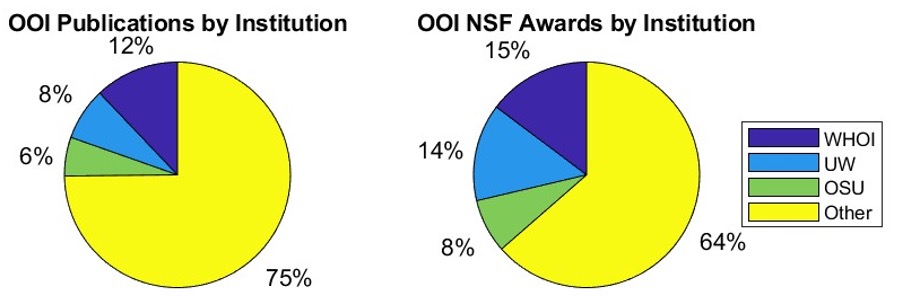 Figure 3. Pie charts showing publications and awards by institutions.[/caption]
Figure 3. Pie charts showing publications and awards by institutions.[/caption]
A Growing Global Reach
OOI’s global reach is wide and deep. Researchers in 22 countries are using OOI data as shown in Table 1. The global accessibility of ocean data to anyone with an Internet connection allows researchers in land-locked countries and States to study the ocean, without having ever to go to sea. To wit, nations other than the United States are increasingly supporting OOI-related research, as reflected in Figures 4. While the NSF is listed as the source of funding for nearly 40% of the publications shown in the Figure 1, the contributions of other federal agencies, foundations, and nations continue to grow, reflecting the value of the data generated by this vital ocean observatory.
This is even more pronounced if the funding sources are broken down by period. For example, Figure 5 shows the funding source statistics prior to and post CY2019. Approximately half of the publications acknowledge NSF funding from 2013 through 2019. The NSF is acknowledged in approximately one-third of the publication since the start of 2020, which is consistent with the results from Figure 1 (bottom panel). The number of publications that do not acknowledge a source of funding has grown from 4% to 7%, which suggests a growing number of researchers using the freely available data without support. A quick look at these publications shows that several of these are PhD theses. The number of papers acknowledging NSF support is still significant, suggesting that our search is missing some of the new starts and should be modified. More importantly, however, the decrease in NSF acknowledgements coincides with a substantial increase in the acknowledgements of support by European and other countries in their published research. The enhanced stature of the OOI as a global research observatory has resulted in growing collaborations with other observing initiatives such as GOOS, POGO, SOLAS, IOOS and SCOR.
[caption id="attachment_26018" align="aligncenter" width="670"]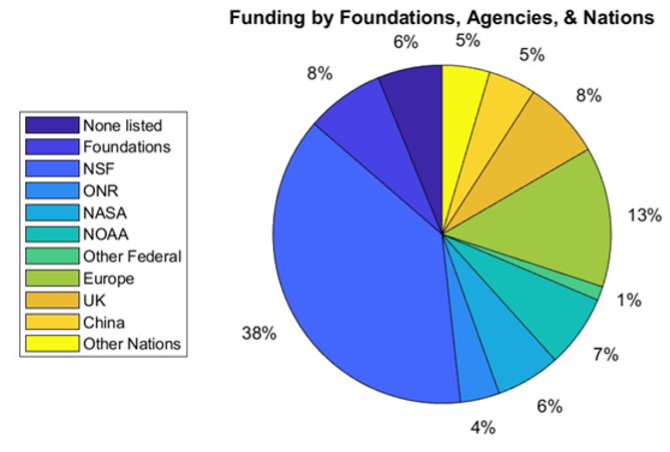 Figure 4. A pie chart showing the foundations, agencies and nations providing support for OOI-related research. Note that the percentages reflect the number of times that these funding sources were acknowledged compared to the total acknowledgements and do not represent the amount of actual funding.[/caption]
Figure 4. A pie chart showing the foundations, agencies and nations providing support for OOI-related research. Note that the percentages reflect the number of times that these funding sources were acknowledged compared to the total acknowledgements and do not represent the amount of actual funding.[/caption]
[caption id="attachment_26019" align="aligncenter" width="932"]
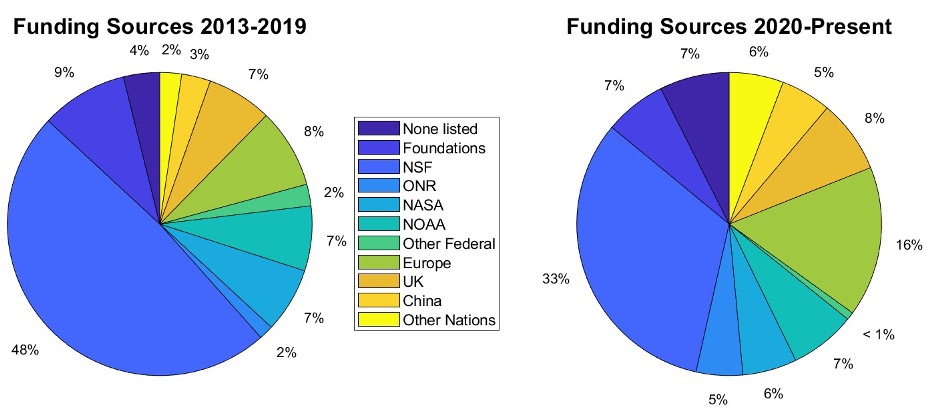 Figure 5. As in Figure 3 but divided into two periods showing acknowledgement of support through 2019 and thereafter.[/caption]
Figure 5. As in Figure 3 but divided into two periods showing acknowledgement of support through 2019 and thereafter.[/caption]
Data Users’ Views
What better way to assess the potential of OOI data than to ask researchers who use it as a foundation for their scientific findings? We share with you some of the views of OOI data users below:
Value of Long-Term Time Series
“The OOI Program offers the opportunity to compare detailed time-series observations of the biological pump across multiple sites, complementing both ship-based process studies (e.g., EXPORTS; Siegel et al., 2016) and more globally wide-spread observations from Biogeochemical-Argo floats and satellites. The OOI arrays represent a diverse set of complementary physical and biogeochemical settings that together could be used to better constrain how interactions between biological and physical processes influence the biological pump.”
– Hilary I. Palevsky, Dept. of Earth & Environmental Sciences, Boston College, Boston, MA, USA
“High resolution and bandwidth ocean observing data from myriad, co-located instrument arrays, such as those provided by the RCA, are crucial to building time series spanning months or years that are required to quantify the flux of methane from the seafloor, possible impacts of ocean warming and seismic events, and the evolution of these highly dynamic environments. Short term or nonsystematic monitoring systems do not provide enough data to produce statistical correlations, nor detect low-frequency cycles with high degrees of confidence. In the years to come, we plan to achieve longer time-series to detect potential non-periodic, low-amplitude influences, possibly from climatic forcing. Such influences can only be reliably inferred with the kind of long-term, systematic sampling methodology made possible by the OOI observatory.”
– Yann Marcon, MARUM – Center for Marine Environmental Sciences, University of Bremen, D-28359 Bremen, Germany
“The six-year record of real-time data flowing from the Regional Cabled Array forms an unparalleled foundation on which to build an ocean drilling program with the International Ocean Discovery Program to understand the relationships between microbial, hydrological, geochemical, and geophysical processes in zero-age, hydrothermally active oceanic crust. Proposed Axial drilling will provide a unique opportunity to determine the nature of subseafloor hydrological properties and develop an unprecedented 3-D understanding of subseafloor processes in unsedimented crust.”
– Julie A. Huber, Marine Chemistry and Geochemistry, Woods Hole Oceanographic Institution, Woods Hole, MA
“The OOI Oregon Shelf site is part of the Coastal Endurance Array. This site, also known as NH-10 as it is located 10 nautical miles offshore along the historic Newport Hydrographic Line, is embedded in the Northern California Current System (NCC). The NCC supports ecologically and economically important fisheries and other marine resources that are impacted by major climate fluctuations: marine heat waves, El Niño, seasonal hypoxia, ocean acidification, and changes in the timing of spring transition to upwelling and fall transition to downwelling. To quantify these types of anomalous events against a baseline of ‘normal’ conditions, we first need decades-long time series to establish what ‘normal’ is (or was). The OOI data collected at the NH-10 site enable us to form these decades-long time series by extending velocity, temperature, and salinity time series from previous programs at NH-10. Together, the OOI data and earlier data form time series that do go back decades, which are very rare for subsurface oceanographic data. The resulting time series can be used to better understand local and basin-scale forcing of physical and biological processes at intra-seasonal, seasonal, interannual, and decadal time scales, as well as detect long-term changes and trends embedded within such variability.”
– Melanie Fewings, College of Earth, Ocean, and Atmospheric Sciences, Oregon State University, Corvallis, OR, USA
Providing Data to Assess Climate Change
“The OOI’s Global Irminger Sea Surface Mooring provided the first multi-winter observations from a high northern latitude surface flux buoy and related them to both localized (100-500 km) intense weather conditions and larger scale (~3000 km) modes of atmospheric variability. The data allowed us to create the first multi-winter characterization of air-sea exchange in the high latitude North Atlantic from observations, including year-to-year variability in the influence of the Irminger Sea tip jet on winter heat loss. We were able to identify a new mechanism by which the atmosphere controls ocean heat loss leading to dense water formation. The results are particularly important as the connection between air-sea exchanges and the ocean circulation is still poorly understood, hindering attempts to understand climate change induced slowdown of the Atlantic circulation and its climate feedbacks.
– Simon A. Josey, National Oceanography Centre, Southampton, UK:
“An important priority for the scientific community is reducing uncertainty in our current quantification of Southern Ocean air-sea CO2 flux and developing the capacity to both predict and monitor how air-sea CO2 flux in this region may change under future climate change. The suite of biogeochemical sensors that were deployed on the OOI Southern Ocean surface mooring provide a unique opportunity to make advances in this quantification of carbon fluxes. In particular, the mooring data provide a valuable opportunity to validate and complement other Southern Ocean in situ carbon system measurements, particularly from biogeochemical Argo floats, as they provide in situ measured wind/atmospheric variables needed to calculate carbon fluxes, high temporal frequency not available on other platforms.”
– Veronica Tamsitt, Climate Change Research Centre, University of New South Wales, Sydney, NSW, Australia and Centre for Southern Hemisphere Oceans Research, CSIRO Oceans and Atmosphere, Hobart, TAS, Australia
“The Regional Cabled and Coastal Endurance Array profiling current meter and CTD data are an incredible novelty for internal tide (ITs) studies, enabling the delineation of the relative contributions of many processes that provide pathways for energy through the ITs and dissipation and mixing. The long duration enables discrimination of processes in frequency that have very similar frequencies, and calculation of the impacts of intermittent inertial waves, long period currents (e.g., eddies; upwelling), and seasonal stratification changes on the shear, strain, and turbulent mixing associated with the ITs. The high vertical resolution enables the differentiation of reversible (i.e., vertical advection) and irreversible (i.e., diapycnal mixing) processes, based on tidal isopycnal displacements. In short, the OOI data offer an incredible opportunity to better understand the critical role ITs play in determining the meridional overturning circulation and oceanic heat budget.”
– Douglas S. Luther, School of Ocean and Earth Science and Technology, University of Hawai’i at Manoa, Honolulu, HI, USA
Improved Understanding of Ocean Processes
“The seismic, geodetic, and hydrothermal data from the OOI Regional Cabled Array at Axial Seamount continues to provide my research group with the opportunity to participate in a thriving community seeking to understand the inner workings of a submarine volcano. The OOI RCA at Axial seamount also provides the long-term observations that help anchor a wide variety of complementary observational studies.”
– William S.D. Wilcock, School of Oceanography, University of Washington, Seattle, WA, USA
“The OOI Pioneer Array at the Mid-Atlantic Bight (MAB) shelf edge provides a unique opportunity for studying subsurface offshore transport of the shelf water. One example is that Pioneer Array moored profilers and gliders captured clear signals of frontal subduction of the shelf water on the edge of an impinging warm-core ring. The subducted shelf water was carried offshore by the anticyclonic ring flow underneath a surface layer of ring water and is invisible on the ocean surface. This form of offshore transport of shelf water had not been realized previously. We used the water mass characteristics captured by the Pioneer Array to develop an ocean model to study the dynamics of the frontal subduction and to quantify the surface-invisible part of the shelf-water offshore transport. Future analysis of Pioneer Array data can provide a more robust quantification of the cross-shelf exchanges at the shelf break and the influence of warm-core rings on the physical and biological properties of the MAB continental shelf.”
– Weifeng (Gordon) Zhang, Applied Ocean Physics & Engineering, Woods Hole Oceanographic Institution, Woods Hole, MA, USA
“At Axial Seamount, the OOI infrastructure combined with constraints on the architecture of the magma plumbing system, provides the opportunity to tie dynamic volcano processes of magma recharge and eruption directly to individual magmatic structures imaged within the volcano interior. It provides the opportunity to answer important questions about how and where melt accumulations form, how melt is transported through the lower crust to feed shallower reservoirs, and how eruptions are triggered. Studies of the deep magma plumbing, conducted within the framework of the even higher-resolution 3D multi- channel seismic imaging data recently acquired at Axial Seamount (Arnulf et al., 2019), would be unprecedented for at any volcano on Earth.”
– Suzanne M. Carbotte, Lamont-Doherty Earth Observatory, Columbia University, Palisades, NY, USA
“Using 4-Dimensional Variational Data Assimilation in a ROMS model (Regional Ocean Modeling System), we undertook a 4-year reanalysis (2014- 2017) of circulation at the Pioneer Coastal Array site. Starting from a 7-km resolution model identical to the MARACOOS ocean forecast system, we refined the resolution through two nested grids to achieve ~700 m horizontal grid resolution in a domain that fully encompasses Pioneer. Though an order of magnitude fewer in number, in situ observations of temperature and salinity from Pioneer moorings and gliders had two to three times the impact of satellite sea level and temperature data on modeled across-shelf fluxes. The study shows that it is feasible to compute very-high-resolution ocean reanalyses that are meaningfully constrained by dense observing networks such as Pioneer. Achieving event-wise correspondence between observed and modeled sub-mesoscale features can provide context to the interpretation of other Pioneer data and opens further opportunities, such as coupling circulation to companion models of biogeochemical and ecosystem processes.”
– John Wilkin, Department of Marine and Coastal Sciences, Rutgers University, New Brunswick, NJ, USA
Read More

